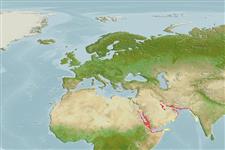Environment: milieu / climate zone / depth range / distribution range
पारिस्थितिकी
समुद्री ड़िमरसल; गहराई सीमा 2 - 17 m (Ref. 12713). Tropical
Western Indian Ocean: Arabian Gulf (Saudi Arabia) and the Red Sea (Eritrea, Egypt and Saudi Arabia).
आकार / वज़न / Age
Maturity: Lm ? range ? - ? cm
Max length : 2.6 cm SL पुल्लिंग / अलिंग; (Ref. 12713); 3.1 cm SL (female)
Short description
आकृति विज्ञान | मौरफोमैटरिक्स
पृष्ठीय रीढ़ (सम्पूर्ण): 7; पृष्ठीय सौफट रेज़ (सम्पूर्ण): 13-14; गुदा कांटा 1; ऐनल सौफट रेज़: 12 - 13; जानवरों की रीड़ का जोड़: 26. This species is distinguished by the following set of characters: D VI + I,13 (rarely I,14); anterior rim of posterior nostril raised, without well-developed flap; mainly cycloid on body; head and body pale, with reticulate mottling dorsally (Ref. 115539).
Found on sand and rubble with small patches of mostly dead coral or at the base of a drop-off.
Life cycle and mating behavior
परिपक्व अवधि | पुनरुत्पत्ति | मछलीऔ का अंडे देना | अंडे | Fecundity | लार्वा
Gill, A.C. and J.E. Randall, 1994. Xenisthmus balius, a new species of fish from the Persian Gulf (Gobioidei: Xenisthmidae). Proc. Biol. Soc. Wash. 107(3):445-450. (Ref. 12713)
IUCN Red List Status (Ref. 130435)
Threat to humans
Harmless
Human uses
अधिक जानकारी
आम नामउपशब्दचपायचयपरभक्षीईकोटोकसीकोलौजीपुनरुत्पत्तिपरिपक्व अवधिमछलीऔ का अंडे देनाSpawning aggregationFecundityअंडेEgg development
Age/Sizeबाढ़Length-weightLength-lengthLength-frequenciesमौरफोमैटरिक्सआकृति विज्ञानलार्वालारवल गतिकीभर्तीबहुतायतBRUVS
संदर्भजलीयकृषिजलीयकृषि रूपरेखाखींचआनुवंशिकीElectrophoresesहैरेटिबिलटीबीमारीप्रक्रमणNutrientsMass conversion
सहयोगीयोतस्वीरेStamps, Coins Misc.ध्वनिसिगुयटिरारफ्तारतैरने के प्रकारगिल क्षेत्रOtolithsदिमागदृष्टि
साधन
Special reports
Download XML
इंटरनेट स्रोत
Estimates based on models
Preferred temperature (Ref.
123201): 25 - 28.9, mean 27.3 °C (based on 129 cells).
Phylogenetic diversity index (Ref.
82804): PD
50 = 0.5020 [Uniqueness, from 0.5 = low to 2.0 = high].
Bayesian length-weight: a=0.00389 (0.00180 - 0.00842), b=3.12 (2.94 - 3.30), in cm total length, based on all LWR estimates for this body shape (Ref.
93245).
Trophic level (Ref.
69278): 3.1 ±0.4 se; based on size and trophs of closest relatives
Fishing Vulnerability (Ref.
59153): Low vulnerability (10 of 100).
